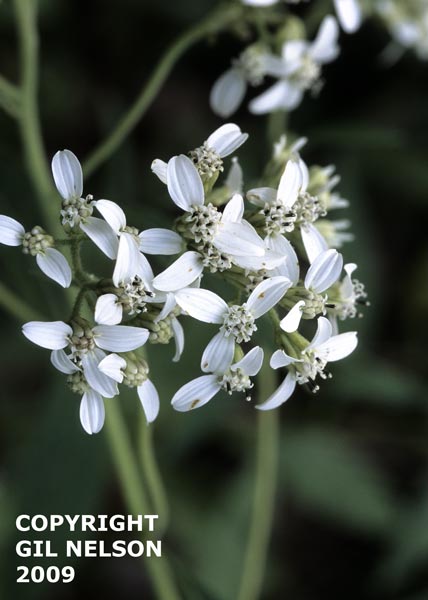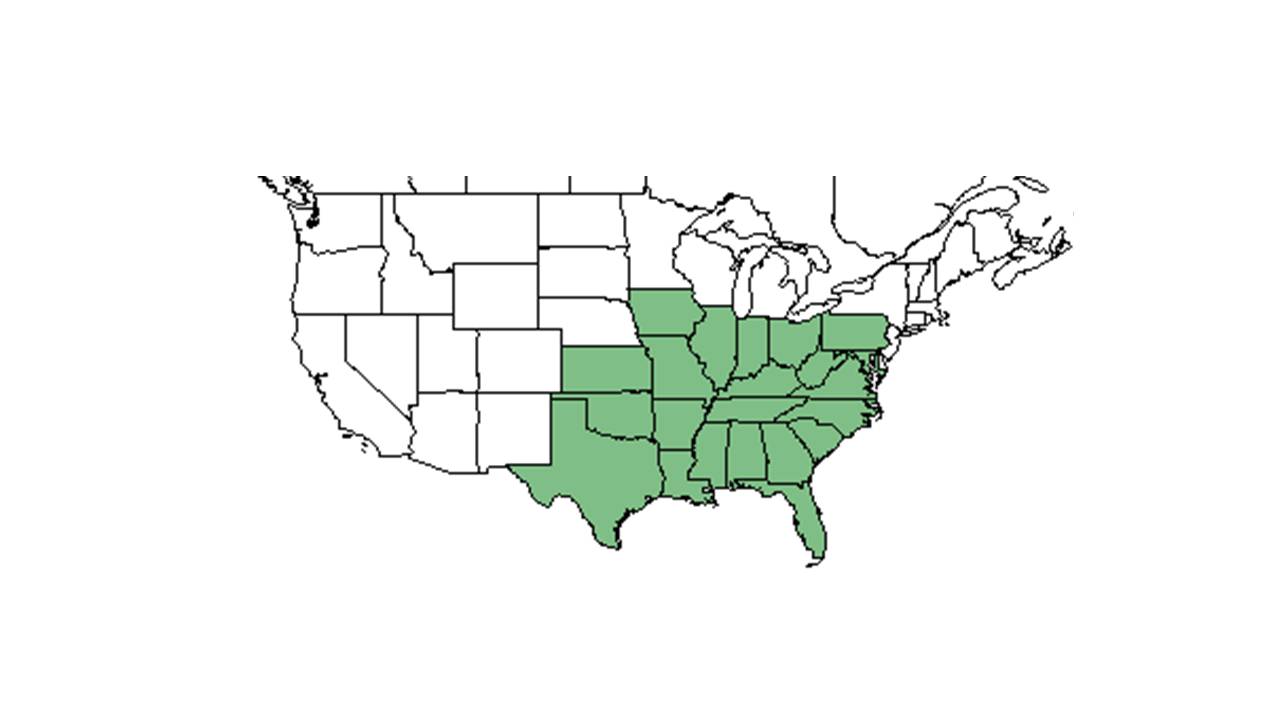Difference between revisions of "Verbesina virginica"
Laurenloria (talk | contribs) |
|||
| Line 31: | Line 31: | ||
Associated species include ''Melanthera nivea, Myrica cerifera, Baccharis, Polymnia, Sabal, Quercus, Schinus, Desmodium ochroleucum, D. rotundifolium Rhynchosia, Rhus aromatica, Polymnia uvedalia, Melanthera nivea'', and ''Calyptocarpus.'' <ref name="FSU Herbarium"/> | Associated species include ''Melanthera nivea, Myrica cerifera, Baccharis, Polymnia, Sabal, Quercus, Schinus, Desmodium ochroleucum, D. rotundifolium Rhynchosia, Rhus aromatica, Polymnia uvedalia, Melanthera nivea'', and ''Calyptocarpus.'' <ref name="FSU Herbarium"/> | ||
===Phenology=== <!--Timing off flowering, fruiting, seed dispersal, and environmental triggers. Cite PanFlora website if appropriate: http://www.gilnelson.com/PanFlora/ --> | ===Phenology=== <!--Timing off flowering, fruiting, seed dispersal, and environmental triggers. Cite PanFlora website if appropriate: http://www.gilnelson.com/PanFlora/ --> | ||
| − | Flowers March through December and fruits September through November. <ref name="FSU Herbarium"/> | + | Flowers March through December with peak inflorescence in September and fruits September through November.<ref name="FSU Herbarium"/><ref>Nelson, G. [http://www.gilnelson.com/ PanFlora]: Plant data for the eastern United States with emphasis on the Southeastern Coastal Plains, Florida, and the Florida Panhandle. www.gilnelson.com/PanFlora/ Accessed: 15 DEC 2016</ref> |
<!--===Seed dispersal===--> | <!--===Seed dispersal===--> | ||
<!--===Seed bank and germination===--> | <!--===Seed bank and germination===--> | ||
| Line 38: | Line 38: | ||
<!--===Use by animals===--> <!--Herbivory, granivory, insect hosting, etc.--> | <!--===Use by animals===--> <!--Herbivory, granivory, insect hosting, etc.--> | ||
<!--===Diseases and parasites===--> | <!--===Diseases and parasites===--> | ||
| + | |||
==Conservation and management== | ==Conservation and management== | ||
==Cultivation and restoration== | ==Cultivation and restoration== | ||
Revision as of 13:09, 15 December 2016
| Verbesina virginica | |
|---|---|

| |
| Photo taken by Gil Nelson | |
| Scientific classification | |
| Kingdom: | Plantae |
| Division: | Magnoliophyta – Flowering plants |
| Class: | Magnoliopsida – Dicotyledons |
| Order: | Asterales |
| Family: | Asteraceae ⁄ Compositae |
| Genus: | Verbesina |
| Species: | V. virginica |
| Binomial name | |
| Verbesina virginica L. | |

| |
| Natural range of Verbesina virginica from USDA NRCS Plants Database. | |
Common names: White crownbeard, Common Frostweed
Contents
Taxonomic notes
Synonyms: Phaethusa virginica (Linnaeus) Britton; Verbesina virginica Linnaeus var. virginica
Description
A description of Verbesina virginica is provided in The Flora of North America.
Distribution
Ecology
Habitat
Verbesina virginica can be found in sandy loams of mixed hardwoods; floodplains; mixed oak-pine woodlands; live oak woods; sandy dunes; slash pinewoods; open calcareous bluffs; scrubs; mesic woodlands of shallow ravines; clay soils of mixed hardwood/cabbage palm communities; calcareous banks of rivers; deciduous upland woods; wet hammocks; swamps; near brackish water; wooded pasture with exposed limestone; low swamp with alluvial soil; pine-oak-hickory woodlands; limestone glades; cedar glade near shallow stream; and wet pine flatwoods. [1]
Associated species include Melanthera nivea, Myrica cerifera, Baccharis, Polymnia, Sabal, Quercus, Schinus, Desmodium ochroleucum, D. rotundifolium Rhynchosia, Rhus aromatica, Polymnia uvedalia, Melanthera nivea, and Calyptocarpus. [1]
Phenology
Flowers March through December with peak inflorescence in September and fruits September through November.[1][2]
Conservation and management
Cultivation and restoration
Photo Gallery
References and notes
- ↑ 1.0 1.1 1.2 Florida State University Robert K. Godfrey Herbarium database. URL: http://herbarium.bio.fsu.edu. Last accessed: July 2015. Collectors: Loran C. Anderson, Kathy Craddock Burks, Robert Kral, Robert K. Godfrey, M. R. Darst, Victoria I. Sullivan, R. E. Perdue, Jr., Richard S. Mitchell, Robert L. Lazor, Jean W. Wooten, Cecil R Slaughter, Marc Minno, George R. Cooley, R. J. Eaton, James D. Ray, Jr., James R. Burkhalter, R. M. Eilers, Andre F. Clewell, J. B. Nelson, S. D. Todd, Delzie Demaree, H. F L. Rock, Robert Runyon, James W. Hardin, J. Mendell, B. C. Tharpe, Fred A. Barkley, J. Haesloop, Sidney McDaniel, Paul L. Redfearn, Jr., R. A. Pursell, W. M. Longnecker, J. P. Gillespie, Lester F. Ward, Harry E. Ahles,, C. L. Lundell, John W. Thieret, Norlan C. Henderson, K. E. Blum, W. D. Reese, O. Hester, A. E. Radford, C. L. Lundell, Amelia Lundell, V. L. Cory, R. Komarek, R. A. Norris. States and Counties: Alabama: Limestone. Arkansas, Hot Springs, Howard, Lawrence, Marion, Polk, Yell. Florida: Brevard, Clay, Dade, Dixie, Escambia, Franklin, Gadsden, Hernando, Hillsborough, Holmes, Jackson, Jefferson, Lee, Leon, Liberty, Osceola, Pinellas, St. John, Taylor, Wakulla, Walton. Georgia: Grady, Thomas, Walker. Kentucky: Jessamine. Louisiana: Iberia, Lafayette, Ouachita. Mississippi: Chickasaw, Coahoma, Hancock, Jackson. Missouri: Douglas, Franklin, Stone. South Carolina: Charleston, Pickens. Tennessee: Davidson, Rutherford, Sumner. Texas: Cameron, Dallas, Gonzales, Hays, Hidlago, Somervell. Compiled by Tall Timbers Research Station and Land Conservancy.
- ↑ Nelson, G. PanFlora: Plant data for the eastern United States with emphasis on the Southeastern Coastal Plains, Florida, and the Florida Panhandle. www.gilnelson.com/PanFlora/ Accessed: 15 DEC 2016